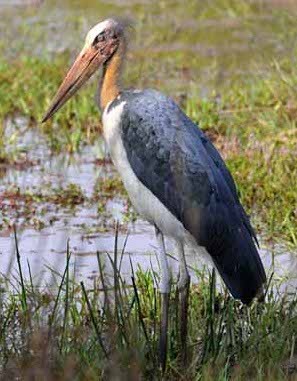Lesser Adjutant
A species of Adjutants and Marabou Scientific name : Leptoptilos javanicus Genus : Adjutants and Marabou
Lesser Adjutant, A species of Adjutants and Marabou
Botanical name: Leptoptilos javanicus
Genus: Adjutants and Marabou
Content
Description People often ask General Info
Description
A large stork with an upright stance, a bare head and neck without a pendant pouch, it has a length of 87–93 cm (34–37 in) (outstretched from bill-to-tail measurement), weighs from 4 to 5.71 kg (8.8 to 12.6 lb) and stands about 110–120 cm (43–47 in) tall. The only confusable species is the greater adjutant, but this species is generally smaller and has a straight upper bill edge (culmen), measuring 25.8–30.8 cm (10.2–12.1 in) in length, with a paler base and appears slightly trimmer and less hunch-backed. The skullcap is paler and the upper plumage is uniformly dark, appearing almost all black. The nearly naked head and neck have a few scattered hair-like feathers. The upper shank or tibia is grey rather than pink, the tarsus measures 22.5–26.8 cm (8.9–10.6 in). The belly and undertail are white. Juveniles are a duller version of the adult but have more feathers on the nape. During the breeding season, the face is reddish and the neck is orange. The larger median wing coverts are tipped with copper spots and the inner secondary coverts and tertials have narrow white edging. The wing chord measures 57.5–66 cm (22.6–26.0 in) in length. Like others in the genus, they retract their necks in flight. In flight, the folded neck can appear like the pouch of the greater adjutant. Males and females appear similar in plumage but males tend to be larger and heavier billed. 
Size
1.1 - 1.2 m
Colors
Black
Yellow
White
Life Expectancy
30 years
Nest Placement
Ground
Feeding Habits
Lesser Adjutant feasts on a varied diet including fish, frogs, reptiles, crustaceans, locusts, rats, and carrion. It employs diverse foraging techniques and shows no hesitation in scavenging, leveraging its keen senses to locate meals. Unique adaptations like a large bill facilitate consumption of this mixed diet.
Habitat
The lesser Adjutant typically inhabits wetland ecosystems, including mangroves, mudflats, coastal swamps, marshes, and flooded grasslands, but can also be found around lakes and rice paddies. Their range extends to broader tropical regions where they favor forested areas near water and are more coastal in comparison to similar species. Despite adaptability, the lesser Adjutant shows less association with human-altered landscapes than some related species, although they may occasionally venture into crop fields.
Dite type
Scavenger
People often ask
General Info
Feeding Habits
Bird food type
Behavior
During one of the threat displays called the "Arching display" that is given in the presence of intruders, adults extend their neck and sometimes give a hoarse wail. Courtship behaviour of the lesser adjutant is identical to other species of the genus Leptoptilos. They are solitary except during the breeding season when they form loose colonies, never exceeding 20 nests in a single colony. 
Distribution Area
The lesser adjutant is often found in large rivers and lakes inside well wooded regions, in freshwater wetlands in agricultural areas, and coastal wetlands including mudflats and mangroves. It is found in India, Nepal, Sri Lanka, Bangladesh (a colony with about 6 nests and 20 individuals was discovered near Thakurgaon in 2011), Myanmar, Thailand, Vietnam, Malaysia, Laos, Singapore, Indonesia and Cambodia. The largest population is in Cambodia. In India they are mainly distributed in the eastern states of Assam, West Bengal and Bihar. It may occur as a vagrant on the southern edge of Bhutan. They are extremely rare in southern India. In Sri Lanka, they are found in lowland areas largely within protected areas, though they also use forested wetlands and crop fields. In Nepal, surveys in eastern districts had suggested that they preferentially use forested patches with small wetlands, largely avoiding crop fields. Additional studies, however, indicate that breeding densities of Lesser Adjutant in central Nepal can be high even on croplands. 
